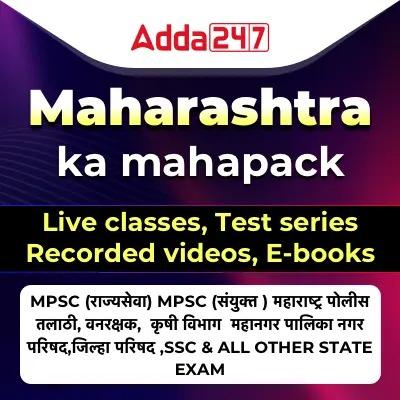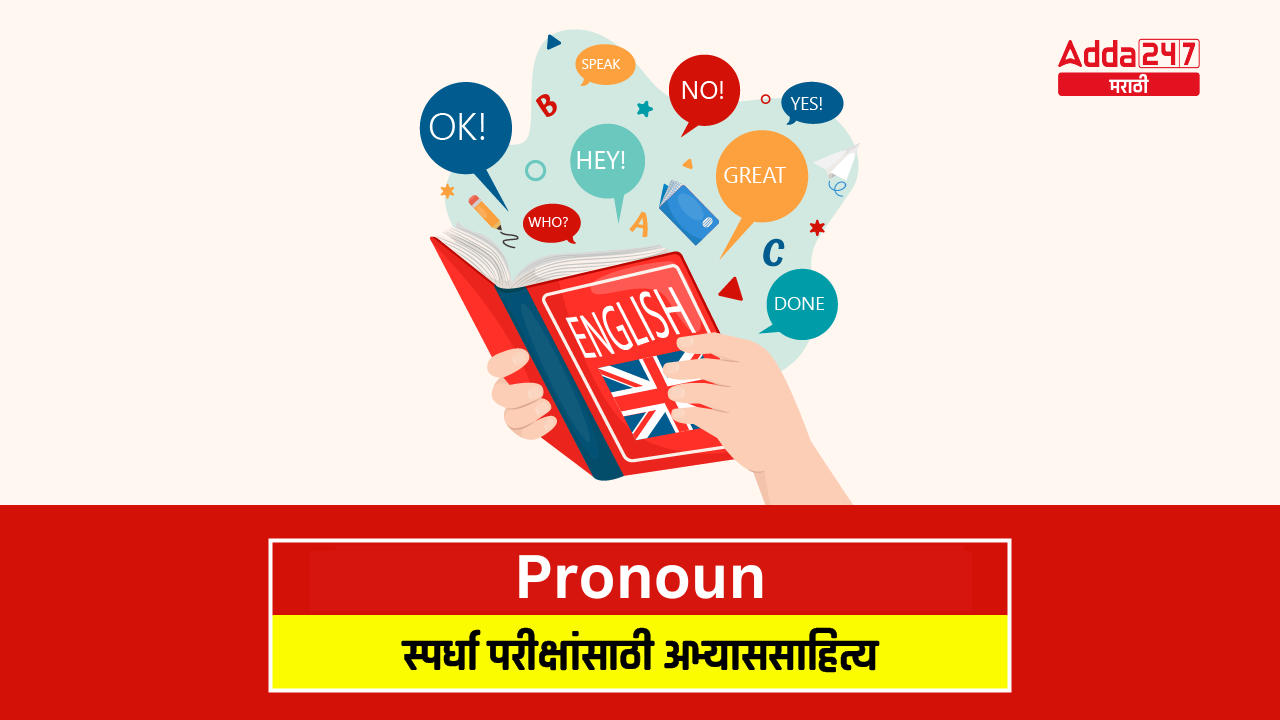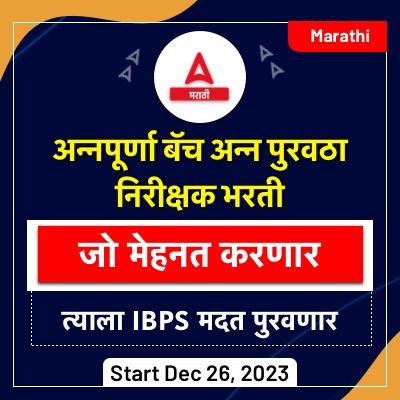Table of Contents
Pronoun
Pronoun: महाराष्ट्रातील तसेच राज्यातील बहुतेक स्पर्धा परीक्षेचा महत्वाचा विषय म्हणजे इंग्लिश. इंग्लिश विषयात जास्तकरून इंग्लिश ग्रामर वर प्रश्न विचारले जातात. नेहमीच्या सरावाने इंग्लिश विषयात चांगले गुण मिळू शकतात. आगामी काळातील सरळसेवा भरती जसे की, अन्न व नागरी पुरवठा विभाग भरती आणि इतर स्पर्धा परीक्षांमध्ये इंग्लिश ग्रामरला विशेष महत्त्व आहे. इंग्लिश ग्रामर चे रोज वाचन फायदेशीर ठरते. इंग्लिश ग्रामर मधील एक महत्वपूर्ण घटक म्हणजे Pronoun. यावर परीक्षेत हमखास 1 ते 2 प्रश्न विचारले जाऊ शकतात. या लेखात आपण Pronoun व त्यातील महत्वाचे नियम यावर माहिती पाहणार आहोत.
Pronoun: विहंगावलोकन
इंग्रजी व्याकरणाचा अभ्यास करतांना Pronoun या घटकाचा अभ्यास करणे महत्वाचे ठरते. या लेखात Pronoun बद्दल सविस्तर माहिती दिली आहे.
| Pronoun: विहंगावलोकन | |
| श्रेणी | अभ्यास साहित्य |
| उपयोगिता | अन्न व नागरी पुरवठा विभाग आणि इतर सर्व स्पर्धा परीक्षांसाठी उपयुक्त |
| विषय | इंग्रजी व्याकरण |
| लेखाचे नाव | Pronoun |
| लेखातील प्रमुख मुद्दे |
|
Pronoun
A Pronoun is a word that is used in place of Noun is order to avoid repetition of a noun in a sentence make our language stylistic.
Pronouns are of Ten Types:
- Personal Pronouns
- Possessive Pronouns
- Reflexive Pronouns
- Demonstrative Pronouns
- Relative Pronouns
- Interrogative Pronouns
- Reciprocal Pronouns
- Universal Pronouns
- Distributive Pronouns
- Indefinite Pronouns
I. PERSONAL PRONOUN
Personal Pronouns are used for three persons:
(i) The person speaking. (First person)
(ii) The person Spoken to (Second Person)
(iii) The person spoken of. (Third Person)
Personal Pronouns include – I, we, he, she, it, they, you, me, etc.
Use of Personal Pronouns
(i) Use of ‘we’ and ‘I’
We and I are used for first person.
For Ex. I am a teacher. We go to School.
(ii) Uses of ‘He’/ ‘She’
‘He’/ ‘She’ is used for third Person.
For Ex. He plays cricket. She goes to market.
(iii) Uses of ‘You’
‘You’ is used for second person.
For Ex. You are a good boy. You should respect your elders.
(iv) Uses of ‘It’
⇒‘It’ is used for animals, infants, insects and non-living things.
For Ex. India is a developing country. It has a great cultural heritage.
It is my car.
⇒‘It’ is used to denote ‘time’, ‘weather’, ‘distance’, ‘temperature’ or any other natural event. It is used only as an ‘Introductory subject’ and has no meaning.
For Ex. It is raining. It is Sunday. It is 6 O’ clock.
⇒‘It’ is also used as a subject to emphasize the noun or pronoun.
For Ex. It was she who passed the exam. It was he who came late.
(v) Uses of ‘They’
⇒ ‘They’ is the plural form of ‘it’ and can be used for mankind, animal, bird, non-living, etc. in plural.
For Ex. They are girls (Mankind)
They are chairs. (Non-livings)
They are cats. (Animals)
There are some rules that must be followed while dealing with personal pronouns. They are as follows:
Rule 1: If all the three persons i.e. first person (1), Second person (2) and third person (3) or two out of three persons are coming in a single sentence, then the order or pronouns that is to be followed is ‘231’.
For Ex – You, he and I have scored good marks. (231)
He and I are going to party (31)
You and He are doing a great job. (23)
Rule 2: If all three persons or two out of three persons are used in a single sentence, which is negative is sense, then the order of pronouns that must be followed is ‘123’.
For Ex – I, you and he are guilty and will be punished.
Rule 3: The order that is to be followed while using Plural Pronouns (They, we, you) is ‘123’.
For Ex – we, you and they will be awarded for the good work we have done.
Rule 4: Words like ‘let’, ‘like’, ‘between ……….and’, ‘but’, ‘except’ and all prepositions are followed by an objective (accusative) case.
For Ex – He looked at me.
Let me complete this work.
Rule 5: In case of a comparison between two nominative case, the pronoun that is use is also of the nominative case:
For Ex – He is as fast as me. (wrong)
He is as fast as I. (correct)
She is better than him. (wrong)
She is better than he. (correct)
II. Possessive Pronoun
Possessive Pronouns are used to indicate possession, for example mine, yours, hers, theirs, ours, etc.
Note: Noun is not used after possessive pronoun.
For Ex
This is mine book. (wrong)
This is yours book. (wrong)
Our, your, her, their, etc are called possessive Adjectives.
Note: Noun is used after possessive adjective
For Ex
That is my car.
This is your pen.
Uses of Possessive Pronouns
(i) When a verb comes in between a noun and a pronoun, possessive Pronoun is used.
For Ex – Yours is the best, mine the worst.
(ii) We can use a Possessive Pronoun as the subject in any sentence.
For Ex – Mine is a new book.
(iii) Possessive Pronoun can be used as the object of a verb.
For Ex – I have my pen as well as yours.
(iv) When a pronoun is preceded by ‘of’, we use possessive pronoun.
For Ex – That pen of yours is lost.
There are some rules which must be followed to ensure grammatical accuracy while studying possessive Pronoun. Some of them are as follows:
Rule 1: Possessive Pronouns are not used with the words like ‘Separation, leave, excuse, mention, report, pardon, sight, favour.
For Ex – She needs your favour. (Wrong)
She needs favour from you. (Correct)
Rule 2: ‘Apostrophe’ is not used in Possessive Pronouns.
For Ex – I have a car. It’s colour is red. (Wrong)
I have a car. Its colour is red. (Correct)
III. REFLEXIVE PRONOUN
Reflexive pronoun are formed by joining suffix – Self to Personal Pronouns of the singular number and-selves to personal pronouns of the plural number. For e.g. – myself, ourselves, herself, himself, themselves, etc.
Uses of Reflexive Pronoun.
1. It is used after some words like acquit, avail, reconcile, amuse, resign, avenge, adapt, adjust, pride, absent and enjoy.
For Ex – One should avail oneself of the opportunity which life gives.
Note:
2. If absent is used as a verb.
If the door is affected by the action and the result, Reflexive Pronoun is used.
For Ex – I cut my finger myself.
3. Reflexive Pronoun is used when the ‘Subject’ emphasizes his action or skill.
For Ex – I will myself complete my work.
We will ourselves face this problem.
Note:
Reflexive Pronoun is not used as a subject or an object of a sentence unless a noun/pronoun precedes it.
For Ex – Myself Sagar from Punjab. (Wrong)
I am Sagar from Punjab. (Correct)
I myself can do this work. (Correct)
Note:
Keep, stop, turn, qualify, bathe, move, rest, hide, etc. are few words which do not take a reflexive pronoun.
For Ex – He hid himself behind the wall. (Wrong)
He hid behind the wall. (Correct)
IV. DEMONSTRATIVE PRONOUN
Demonstrative Pronoun are those pronouns that are used to point towards something specific within a sentence.
For Ex – this, that, these, those, such, one, etc.
Uses of Demonstrative Pronoun
1. ‘This’ is used for singular nouns that are placed closer.
For e.g.: This is a pen.
2.‘These’ is used for plural pronouns that are placed for near.
For e.g.: These are pens
3. ‘That’ is used to demonstrate singular nouns that are placed for.
For Ex – That is a pen.
4. ‘Those’ is used to demonstrate Plural Nouns that are placed far.
For Ex – Those are pens.
5. ‘One’ and ‘Ones’ are used as substitutes for nouns.
For Ex – I have lost my book, but I have got one (book) from my friend.
6. ‘Such’ is also used as a substitute for a Noun.
For Ex – I am a teacher. And as such(a teacher)I should be unbiased.
V. RELATIVE PRONOUN:
A Relative Pronoun is one which relates a clause or phrase to a noun or a pronoun.
For Ex – Who, which, that, etc.
Uses of Relative Pronoun:
1. ‘Who’ and ‘Whom’ are used for humans in subjective and objective
cases respectively.
For Ex – She is the girl who teaches English.
They are the students who she teach.
2. Which is used for all except humans.
For Ex – this is the car which I bought.
3. Whose is used in Possessive case.
For Ex – These are the children whose father has died.
4. If a human and a non-living thing/ animal are joined by ‘and’, then a relative pronoun ‘that’ is used.
For Ex – The girls and her dog that I saw least Sunday have
5. After a superlative degree, ‘That’ is used
For Ex – She is the most beautiful girl ‘that’ I have ever seen.
6. Words like Everything, nothing, anything, the only, the few, the little, the same etc are used with ‘that’.
For Ex – I gave him the few pens that I had got.
She is the same girl that helped me.
VI. Interrogative Pronoun
Interrogative Pronouns are used for asking question.
For Ex – Who, which, what, etc.
Uses of Interrogative Pronouns.
1.Who is used to ask about the subject.
For Ex – who is she?
2. Whom is used to ask about the object.
For Ex – Whom have you called?
3. Whose is used to ask about the possession of something.
For Ex – Whose car is that?
Note: ‘Whose’ is not used for non living things.
For Ex. – This is the pen whose cap was lost. (Wrong)
This is the pen, the cap of which was lost. (Correct)
4. Which is used for both persons and things if a choice is to be made
between two or more.
For Ex – ‘Which’ of the two cars is yours?
5. Where, why andwhen are used as interrogative pronouns for place,
reason and time respectively.
For Ex – where is your book? (Place)
Why are you sad? (Reason)
When will you come here? (Time)
VII. Reciprocal Pronoun
Pronouns that indicate a mutual relationship are called Reciprocal Pronouns.
Each other and One another are the two Reciprocal Pronoun.
Uses of Reciprocal Pronoun
1. Each other is used to denote a relationship between two subjects.
For Ex – Meenakshi and her sister love each other.
2. One another is used to denote a relationship among more than two
subjects.
For Ex – All the team members support one another.
महाराष्ट्रातील सर्व स्पर्धा परीक्षांसाठी ऑनलाईन क्लास, व्हिडिओ कोर्स, टेस्ट सिरीज, पुस्तके आणि इतर अभ्यास साहित्य खाली दिलेल्या लिंक वर क्लिक करून मिळावा.
अड्डा 247 मराठी अँप | अड्डा 247 मराठी टेलिग्राम ग्रुप








